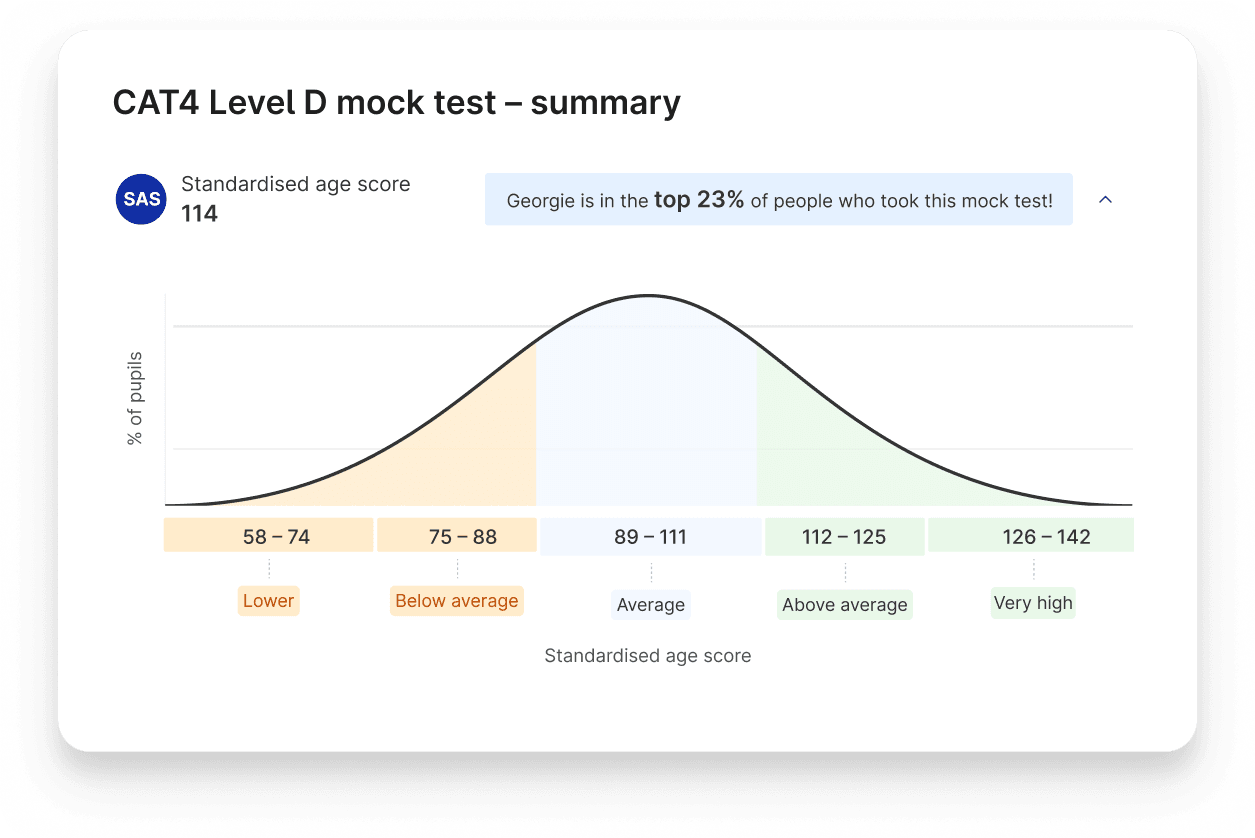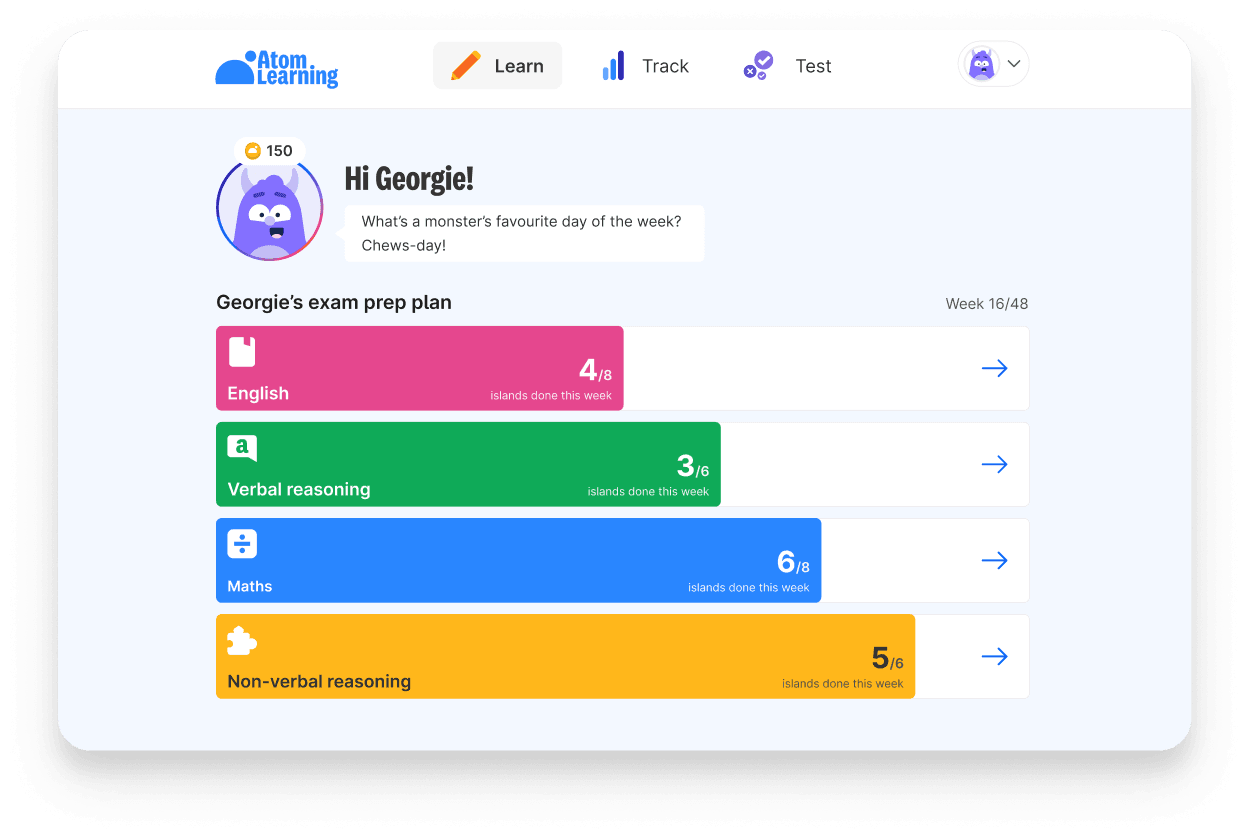Contents
If your child is taking the CAT4 test, this guide will help you and your child understand what to expect.
Read on to:
Find out why schools use the CAT4
Understand the format and structure of the CAT4
Learn how the CAT4 is scored
Discover how to help your child prepare
Plus, sign up for Atom's free CAT4 course – including video lessons and CAT4 practice papers!
What is the CAT4?
CAT4 stands for Cognitive Abilities Test. It's created by GL Assessment – a UK exam provider (who provides a lot of 11 plus tests).
The CAT4 is a non-adaptive test: every child answers the same questions in the same order. It is designed to assess a child’s reasoning ability.
It is also a standardised test, the test has been standardised on around 25,000 children in the UK and Ireland. This means a child’s performance can be reliably compared to other children of the same age in the UK.
What is the CAT4 used for?
Schools use CAT4 tests for a range of reasons. The results help teachers understand how children think and solve problems. While exams like SATs or GCSEs assess what pupils have learned in class, CAT4 focuses on reasoning skills. This gives a clearer picture of how a child might learn and develop over time.
The results can highlight strengths that may not be obvious in lessons and show where extra support could make a difference. They also help schools set learning goals and organise teaching groups more effectively.
Schools use CAT4 to:
Assess students for admission to selective schools (grammar and independent)
Put students into groups based on academic ability (also known as streaming!)
Predict future exam results (e.g. predicted grades for GCSEs)
Teachers use CAT4 to:
Understand each student’s ability and potential
Spot strengths and provide extra challenge
Identify who needs more support
Plan the best ways for each child to learn
Support the move from primary to secondary school
What are the CAT4 levels?
The CAT4 test has 10 available levels which are aimed at different age groups. The content in each level is appropriate for that age group.
The most commonly used levels are A–G. If your child is taking the CAT4 as an 11 plus exam, they will likely take Level C or Level D.
Try Atom's free CAT4 course
Is your child taking a CAT4 test? Atom's free CAT4 course is here to help them feel confident! Your child will master tricky topics, refine exam skills, and practise CAT4-style questions.
Structure of the CAT4
The CAT4 test is a timed assessment of 72 minutes, taken under exam conditions. It's available to schools as both a paper-based and online test.
Children will be assessed through multiple-choice questions across four 'batteries':
Verbal reasoning
Quantitative reasoning
Non-verbal reasoning
Spatial reasoning
Let's take a look at some example CAT4 questions for each section.
Part 1
The first section of the CAT4 test assesses non-verbal reasoning. This involves solving problems and identifying patterns using pictures and diagrams. Many selective schools include 11 plus non-verbal reasoning as part of their Year 7 selection process.
In the CAT4, non-verbal reasoning is assessed through:
Figure classification - 10 minutes (available on Atom Home)
Figure matrices - 10 minutes (available on Atom Home)
Children are not allowed to use any additional resources such as a pencil or scrap paper in this section.
Figure classification
Figure classification tests your child’s ability to recognise and understand visual patterns.
They will see a pair or a group of shapes which are similar in some way. They will then choose one of five options that follows the same pattern.
Answer: E. In the example pair, a large black shape has a smaller white version of the same shape overlapping it. Option E follows the same pattern: a large black circle with a smaller white circle overlapping it.
Figure matrices
Figure matrices test your child’s ability to spot and apply changes between shapes.
They’ll see a grid of shapes with one missing. To find the missing piece, they’ll need to work out how the shapes change across the grid and choose the option that fits.
Answer: C. Each row follows a pattern where the circle colour changes (black → white → grey) and the background corner shading rotates (grey → black → hatched). In the top row, the missing shape must be a grey circle with a grey shaded corner, which matches option C.
Part 2
The second part of the CAT4 test assesses verbal reasoning and quantitative reasoning.
Verbal reasoning tests how we think and solve problems using written information. Many grammar and independent schools include 11 plus verbal reasoning as part of their Year 7 entry process.
Quantitative reasoning is designed to test maths skills and involves processing patterns using numbers.
Part 2 of the CAT4 test consists of three individually-timed sections:
Verbal classification - 8 minutes (available on Atom Home)
Verbal analogies - 8 minutes (available on Atom Home)
Number analogies - 10 minutes (available on Atom Home)
Children are not allowed to use any additional resources in this section.
Verbal classification
In the verbal classification test, children will see a group of words. They will need to select two words which have the most closely associated meaning.
Answer: C (prove) and E (open). Ticket, label and tag are closely linked because they are items you attach to something to give information. Prove and open are different because they describe actions, not objects.
Verbal analogies
In the verbal analogies test, your child needs to work out the relationship between a pair of words. They are given two sets of options in brackets and must choose one word from each set to complete the sentence.
Answer: C (solve) and F (break). We solve a puzzle and we break a code. This keeps the same verb–noun relationship in both parts of the sentence.
Number analogies
In these questions, your child will see pairs of numbers. The first number is linked to the second by a rule. One number is missing in the last pair. Your child must figure out the rule between the first and second numbers, then use it to find the missing number.
Unlike in the previous tests, your child will be allowed a pencil and paper for working out in this section.
Answer: B (60) The same rule links each pair: multiply the first number by 12.
Part 3
The third and final part of the CAT4 test involves more quantitative reasoning questions and spatial ability. This is a skill which involves transforming visual images in the mind. It's commonly used in STEM subjects (science, technology, engineering and maths).
There are three shorter timed sections:
Number series - 8 minutes (available on Atom Home)
Figure analysis - 9 minutes (available on Atom Home)
Figure recognition - 9 minutes (available on Atom Home)
Your child will be allowed a pencil and paper for rough working out in the number series section, but not for figure analysis or figure recognition.
Number series
Your child will see a sequence of numbers which are linked by a rule. They need to analyse the numbers to work out the rule, then apply it to find the missing numbers in the sequence.
Answer: A (36). The sequence increases by 7 each time, so the missing number is 36.
Figure analysis
In the figure analysis test, your child will see an image of a square that has been folded and had holes punched out of it.
They will need to visualise how the square would look if it was unfolded, and select the correct square from five options.
Answer: B. When unfolded, the cuts repeat across the folds, making six circles in two rows and three triangles down the right side - just like option B.
Figure recognition
Your child will need to spot a simple shape hidden within a more complex one, choosing the correct option from five choices.
Answer: C. Option C contains the same triangle: a long base with two equal sloping sides forming a peak. If you trace over C, you can see the outline hidden within the overlapping shapes.
How is the CAT4 marked?
A computer marks the CAT4 test. Your child gets a mark for each correct answer, and these are added to make a raw score.
This score is then converted into a Standardised Age Score (SAS). This takes your child’s exact age into account, so younger children are not at a disadvantage. The SAS is the main score schools look at. A score of 100 means a child is exactly average for their age.
The test will provide schools with other key pieces of data, such as:
National percentile ranking (NPR): indicates how the student's score compares to the national cohort, ranked from low (0) to high (100).
Stanine rank (ST): often seen as a visual representation of your child's SAS score when mapped onto a curve, from 1 (low) to 9 (high). A stanine rank of 5 indicates that the child is working at the average ability level for their year group.
The image below shows a student's data after completing a CAT4 practice test on Atom.
What is a good CAT4 score?
Most selective schools are looking for a standardised score of at least 115, and sometimes higher, for Year 7 candidates.
If your child is taking the CAT4 test as part of a streaming process or to work out predicted future grades, your child's school might share their results with you. If you have any questions about your child's results, we always recommend talking this through with their school.
CAT4 FAQs
No – CAT4 is a non-adaptive test. All of the questions are pre-determined, and children taking the same test at the same time will see the same questions.
How can I support my child’s CAT4 exam success?
Wish you could give your child a roadmap to success in the CAT4? You can. Atom Home has everything you need to get prepared, in one package.
Tailored exam preparation plans for your child's target schools
Unlimited online mock tests for the ISEB, CAT4, Cambridge Select Insight and individual schools
Intelligent progress tracking with detailed data on your child's progress
Expert support with live lessons and webinars
Take the stress out of CAT4 prep
Start your free trial today. We'll get to work on your child's plan so you can relax – CAT4 prep is sorted.
Contents










